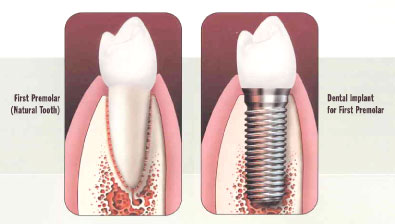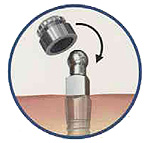Dental Implants
The healthiest thing to do when you lose a tooth is have it replaced. Otherwise, you risk problems with biting, chewing and speaking, headaches, muscle pain and an unattractive appearance. Fortunately, there are many comfortable, secure, natural-looking types of dental implants for tooth replacement.
Dental implants serve as the base for many tooth-replacement options, including bridges, dentures and individual artificial teeth. Implants are surgically implanted in the jaw to provide a comfortable, secure fit and a natural look.
In the first one or two appointments, the post or anchor is implanted in the jaw. The replacement tooth, bridge or denture is fitted and installed when the bone and gums have healed. Surgery may be performed in an office with local anesthesia. Some patients prefer to have sedation to lessen their awareness when they undergo the surgical procedure.

What are dental implants?
Dental implants are metal anchors implanted in the jawbone to hold replacement teeth in place. The “root” sits in the jawbone below the gumline and the visible tooth, or “crown,” is attached to it. Implants support individual artificial teeth, bridges and dentures, and look and feel much like natural teeth.
Am I a candidate for dental implants?
Dental implants are an attractive option for patients who have lost one or more teeth, cannot chew or smile comfortably, or are not happy with dentures. To be considered for dental implants, you must be in good overall health and have strong gums and bones. You must follow excellent oral hygiene, including brushing, flossing and regular dental examinations. Patients with a high risk of developing periodontal (gum) disease, such as smokers and diabetics, may not be good candidates. Your dentist will review your oral health and take x-rays to determine your eligibility.
How is a dental implant placed?
The first step is surgery to place the anchor of the implant into the jawbone. The procedure may take several hours under local or general anesthesia. You will then wait for the bone to heal firmly around the implant, which takes from six weeks to six months.
The metal post that attaches the tooth to the anchor may be placed during the same surgery or in a second procedure.
When the gums have healed, your artificial teeth will be made and fitted on the post. This often requires x-ray images, impressions, and bite registration records, so it may take several appointments over a few months to get your new teeth fitted properly.
What are the benefits?
Dental implants fit snugly in the mouth, allowing you to chew normally. They are cosmetically similar to natural teeth, so you can smile without being self-conscious. Implants also prevent decay in the jawbone that accompanies tooth loss.
Are there any risks involved?
Dental implant surgery is safer now than ever before. Nevertheless, as with any other surgery, some risks exist. These include complications from surgery such as excessive bleeding and reaction to anesthesia. Your dentist will discuss the risks with you in greater detail.
Will my teeth feel natural?
Yes, dental implants look and feel much like natural teeth. Artificial teeth are constructed to mimic real ones, and implants are fused to your jawbone so they feel snug. Implants are often more comfortable and fit more securely than other replacement options.
For more information about Dental Implants, please click here »
MDL Dental Implant
 As in many aspects of medicine and technology, the art of miniaturization can offer a host of new and exciting advantages. This is especially true for denture wearers, who are often plagued with a multitude of problems. MDL Implants (the heart of the retentive system) are dental implants scaled down to a smaller dimension with a modified self-threading pilot tip. The process of miniaturization also offers significant benefits… you no longer have to deal with multiple surgeries and extended healing periods. The mini implant simply threads itself into the bone and is immediately held tightly in place. It creates its own “surgical site” as it is placed and the elastic properties of your jawbone provide immediate fixation and stabilization, This procedure can be accomplished in one session and your existing denture can easily be retrofitted for the system. Thanks to the MDL Denture Retention System technology, in addition to a pleasant, natural-looking smile, you should be able to wear dentures that are solid, secure, stable and functional.
As in many aspects of medicine and technology, the art of miniaturization can offer a host of new and exciting advantages. This is especially true for denture wearers, who are often plagued with a multitude of problems. MDL Implants (the heart of the retentive system) are dental implants scaled down to a smaller dimension with a modified self-threading pilot tip. The process of miniaturization also offers significant benefits… you no longer have to deal with multiple surgeries and extended healing periods. The mini implant simply threads itself into the bone and is immediately held tightly in place. It creates its own “surgical site” as it is placed and the elastic properties of your jawbone provide immediate fixation and stabilization, This procedure can be accomplished in one session and your existing denture can easily be retrofitted for the system. Thanks to the MDL Denture Retention System technology, in addition to a pleasant, natural-looking smile, you should be able to wear dentures that are solid, secure, stable and functional.
For more information about MDL Dental Implant, please click here »


